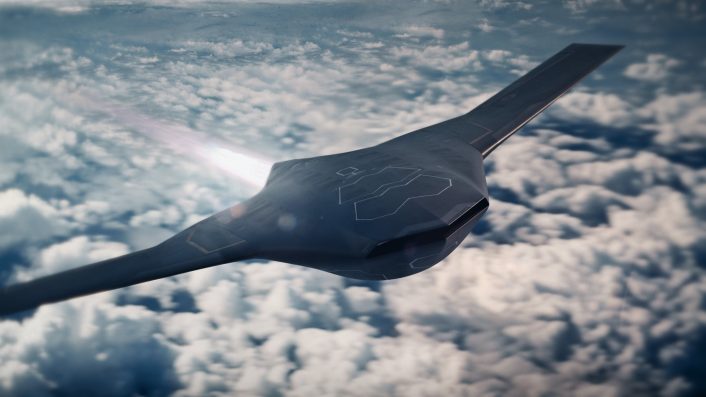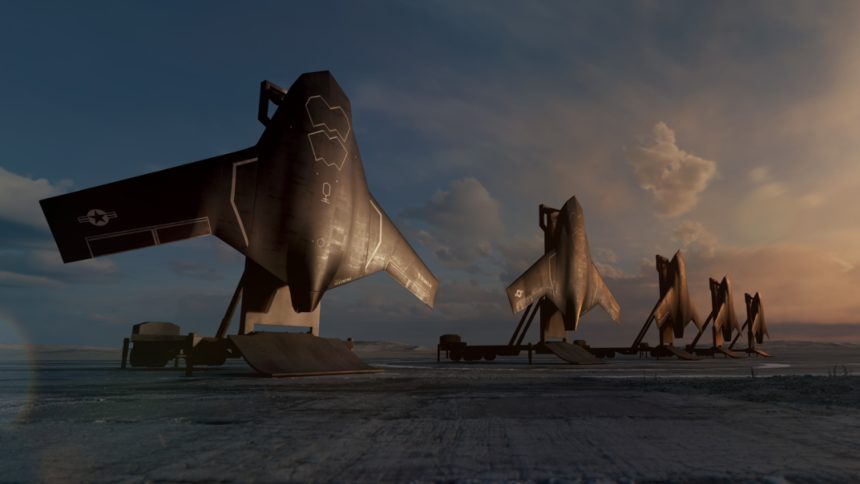Shield AI has revealed the X-BAT, a vertical take-off stealth jet designed for runway-free operations and powered by the firm’s Hivemind AI pilot.
U.S. defense technology company Shield AI has unveiled its latest project, the X-BAT vertical take-off and landing (VTOL) stealth drone, designed to operate autonomously in communications-denied environments without the need for a runway. The announcement was made on Oct. 21, 2025, in Washington, D.C., during an event attended by defense industry and government officials, where a scale model of the aircraft was also displayed.
The company described X-BAT as a Group 5 unmanned aerial system (UAS), the largest class under Pentagon terminology which has a maximum gross takeoff weight (MGTOW) in excess of 1,320 lb. The aircraft is capable of runway-independent operations, launched from a trailer with a vertical launch rail also used for the recovery, and long-range missions.
“X-BAT represents the next part of our plan, expanding U.S. and allied warfighting capacity through a transformative, runway-independent aircraft. Airpower without runways is the holy grail of deterrence. It gives our forces persistence, reach, and survivability, and it buys diplomacy another day.”
— Brandon Tseng,President and Co-founder of Shield AI
A stealthy, runway-independent ‘strike jet’
The X-BAT is a low-observable tailless flying-wing aircraft featuring folding wings, which allow it to be transported and launched within minutes from a truck trailer. Computer-generated videos by Shield AI show the X-BAT raised vertically for takeoff, after which it transitions into standard forward flight to conduct its mission, and then returns to its trailer for a vertical recovery, landing on its tail.
“Those two things — AI piloted and vertical takeoff launch and land — have never come together in the form of a next generation aircraft.”
— Brandon Tseng, President and Co-founder of Shield AI
The company lists the length of the aircraft at 26 ft (7.9 m), wingspan at 39 ft (11.9 m), and a service ceiling above 50,000 ft, with an operational range exceeding 2,000 nautical miles (3,704 km). Its maximum speed remains classified, though Aviation Week reports the aircraft will be capable of supersonic flight, powered by the F-16’s engine, which uses either the GE Aerospace F110 or Pratt & Whitney F100, depending on the variant.
During the unveiling, Shield AI showed renderings of the X-BAT carrying AIM-120 and AIM-174B air-to-air missiles internally. The aircraft will include both an internal weapons bay – holding at least two weapons – and an unspecified number of external hardpoints, supporting payloads for strike, intelligence, surveillance, reconnaissance, or electronic warfare missions.
Earth is our runway.
Introducing X-BAT, the world’s first AI-piloted VTOL fighter jet. With vertical takeoff and landing, long range, and full autonomy, X-BAT delivers combat power anywhere, anytime. This is the future of airpower.
Watch the video: https://t.co/K4abUZa23z… pic.twitter.com/AnELEPOfLV
— Shield AI (@shieldaitech) October 21, 2025
“Fighter-class” propulsion and thrust-vectoring technology
While Shield AI has not yet disclosed its propulsion partner, the X-BAT is designed to use a fighter-class afterburning engine, as mentioned earlier. Speaking with Breaking Defense, Armor Harris, Shield AI’s Senior Vice President of Aircraft, further confirmed the aircraft features an “F-16-class engine.”
This will be paired with the thrust vectoring nozzle “originally developed for a late 1990s F-15 thrust vectoring program,” referring to the F-15 ACTIVE (Advanced Control Technology for Integrated Vehicles). Another similar system was developed for the F-16 Multi-Axis Thrust Vectoring (MATV) in the 1990s.
Harris stated that the company plans to build five mobile launch trailers per aircraft, according to Aviation Week, enabling vertical takeoff and recovery without fixed infrastructure. Shield AI also displayed concept art showing X-BAT operations from U.S. Navy ships and commercial cargo vessels, hinting at potential naval applications from ships, and expeditionary operations from remote islands and austere forward bases.
Autonomy through Hivemind
Central to the X-BAT’s capability is Hivemind, Shield AI’s AI-based flight autonomy software already deployed across various U.S. military programs, about which we reported multiple times here at The Aviationist. The system enables uncrewed aircraft to navigate, coordinate, and engage targets autonomously in GPS and communications jammed environments, says the company.
“Because it is AI-powered by our combat-proven Hivemind, it can fly solo, or act as a drone wingman, collaborating and maneuvering with crewed fighters.”
— Armor Harris, Shield AI’s senior vice president of aircraft engineering
Breaking Defense reported that Harris described X-BAT as a “complete” system, with Hivemind as its onboard pilot. However, the company confirmed that the platform will also support third-party autonomy software if required by future customers.
As we previously reported here at The Aviationist previously reported, Shield AI’s Hivemind has been demonstrated aboard Kratos BQM-177 drones and is being integrated into Anduril’s YFQ-44A, one of the prototypes selected under the first phase of the U.S. Air Force’s Collaborative Combat Aircraft (CCA) program.

Flight test roadmap and production outlook
According to Aviation Week, quoting Harris, Shield AI expects to conduct the X-BAT’s first vertical takeoff and landing trials in fall 2026, followed by full-system flight testing and operational validation in 2028.
Harris declined to disclose specific pricing but stated that the cost would be “similar to other Collaborative Combat Aircraft,” which Aviation Week estimates at around $30 million per airframe. Shield AI also confirmed that industrial partners for production and engine supply will be announced “in the coming weeks.”
“X-BAT delivers capabilities beyond the first Increment 1 CCAs, including electronic warfare, greater payload capacity and extended range.”
— Armor Harris, Shield AI’s senior vice president of aircraft engineering
It is unclear if the company has already plans to submit proposals for the next phases of the CCA program. As previously reported, GA-ASI and Anduril were selected for the Increment 1 of the CCA program, with an Increment 2 to follow in 2026.









